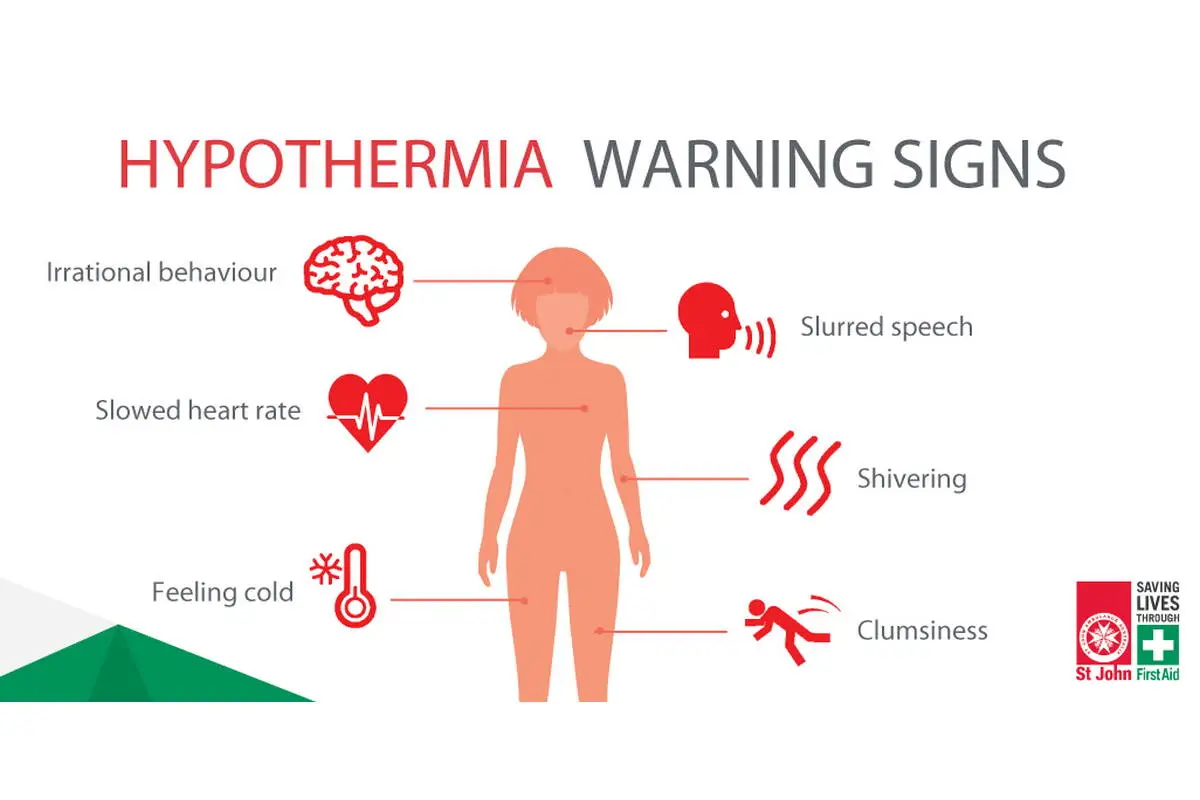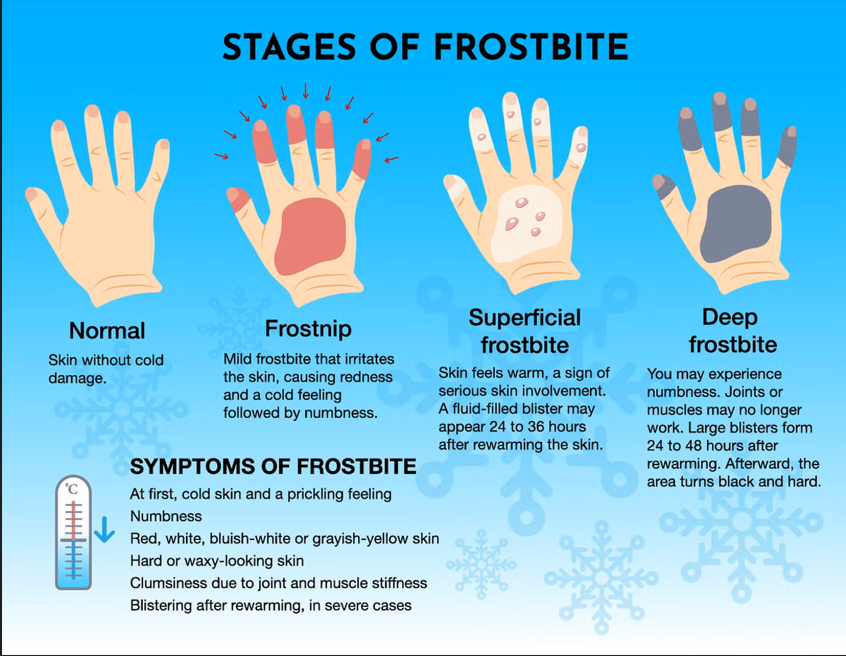
Introducing: Tip of the Month
Introducing our newest initiative – the ‘Tip of the Month’ feature on the Northwest Region Prehospital Care Program’s Learning Management System. Activate the QR code below for monthly insights, valuable tips, and expert guidance to enhance your prehospital care skills. Elevate your learning experience with our curated tips designed to empower and inform. Let the journey to continuous improvement begin!
Tip of the month
Winter Emergencies: Recognition and Care for Hypothermia and Frostbite
Hypothermia is a dangerous drop in core body temperature below 35°C, affecting the whole body, including the brain and organs, and can be fatal if untreated. Symptoms progress from shivering and confusion to loss of coordination, unconsciousness, and death, often caused by prolonged exposure to cold, wet, or windy conditions.
Frostbite is the freezing of skin and underlying tissues, usually in extremities like fingers, toes, nose, or ears. It causes localized numbness, pale or gray skin, and a hard or waxy feel, with severe cases leading to blisters or tissue death. While frostbite can cause permanent damage or amputation, it does not kill by itself.
Objective
Describe and differentiate the stages and clinical presentations of hypothermia and frostbite
Scenario
You attend the scene for a group of individuals with two of them requiring care, both feel cold to the touch.
One is a 46 year old male pt who is complaining of foot pain, upon a physical exam you note his toes are white and he has limited mobility. He is not dressed for the weather. The other is a 52 year old female who is lethargic with decreased mobility and states she has no complaints.
Which one of them do you suspect may be suffering from hypothermia?
Key Content
Stages of Hypothermia
|
Stage |
Patient Features |
Recommended Paramedic Actions |
|
Mild 32-35 ‘C |
Shivering, alert |
Passive rewarming, remove wet clothing, keep dry and insulated |
|
Moderate 28-32’C |
No shivering, altered mental status |
Active external rewarming (heat packs) warmed IV fluids, cardiac monitoring |
|
Severe < 28’C |
Unconscious, bradycardia, arrhythmia risk |
Gentle handling, cardiac monitoring, active external rewarming, remove wet clothes |

Takeaway Message
Hypothermic patients can be challenging to assess because their signs and symptoms—such as altered mental status, bradycardia, hypotension, and shallow respirations—closely mimic those of other medical emergencies like overdose, stroke, or sepsis. This overlap can delay recognition and appropriate treatment, especially in urban environments where hypothermia may not be top of mind. Maintaining a high index of suspicion, especially in vulnerable or exposed populations, is key to early identification and care.
For further information regarding hypothermia and treatment please follow this link to watch a video with our very own Dr. Jon Smith.
November Tip of the Month - Not "Just" the Flu: Recognizing High-Risk Respiratory Illness
As we move into colder weather and more indoor-based activities there is typically a rise in respiratory illnesses. While these illnesses often appear mild or routine, they can lead to serious complications in vulnerable populations such as children, older adults, and those with chronic respiratory disease.
Objective: By the end of this tip, paramedics will be able to identify high-risk patients with respiratory illness and anticipate complications unique to pediatric, geriatric and respiratory compromised populations.
Scenario: During your shift, you assess two patients with flu-like symptoms:
• A 21-year old male with no significant medical history.
• A 78-year old female with a history of chronic COPD.
Question: Who is at a higher risk for deterioration – and why?
Key Content:
Why are we concerned about vulnerable populations ?
| Population | Key Vulnerabilities | Potential Complications | Assessment & Management Considerations |
|
Pediatrics
|
|
|
Assess for: agitation, hydration status, mental state, feeding, lethargy, adventitious sounds
Manage with: oxygen, assisted ventilations as required, nebulized bronchodilators or epinephrine (as indicated), IV access if available, continuous reassessment. Red Flags: rapid fatigue, cyanosis, poor tone, persistent tachypnea, apnea
|
|
Geriatrics
|
|
|
Assess for: altered mentation, dehydration, increased work of breathing, adventitious sounds Manage with: oxygen, ventilatory assistance as needed, cautious IV fluids (avoid overload), medication per ALS PCS, frequent reassessment. Red Flags: new confusion, hypotension, new-onset dysrhythmia, increasing fatigue or hypoxia despite oxygen. |
|
Respiratory Compromised Individuals (COPD, cystic fibrosis, immunocompromised, etc)
|
|
|
Assess for: deviation from baseline respiratory pattern, mental status change, accessory muscle use, fatigue, dehydration Manage with: oxygen (titrate to baseline SpO₂), CPAP or assisted ventilation if required, bronchodilators/steroids per ALS PCS, IV fluids if indicated, continuous reassessment. Red Flags: rising CO₂ retention signs (drowsiness, confusion), poor air entry, exhaustion, silent chest. |
Takeaway Message
Effective patient care requires looking beyond the surface presentation. Two patients with similar symptoms can carry very different risks. Early recognition of vulnerable populations, and awareness of their unique physiology, is key to preventing decompensation and improving outcomes.
Reflection
Think back to your last respiratory call. Did you notice early sign of fatigue, subtle changes in mentation or other early warning signs? How might your assessment, communication or management differ next time for a pediatric, geriatric, or respiratory-compromised patient next time?
October Tip of the Month - Diabetic Emergencies
Diabetic emergencies are among the most common and potentially reversible causes of altered mental status encountered prehospitally. Rapid recognition is essential to preventing serious complications. Within the ALS-PCS and BLS-PCS, paramedics are empowered and expected to assess, manage and transport patients experiencing hypoglycemia or hyperglycemia safely and effectively.
Whether caring for a known diabetic or an undiagnosed patient with non-specific symptoms, a strong understanding of the pathophysiology, clinical presentation and treatment options can be the difference between deterioration and recovery.
September Tip of the Month - Sepsis
Suspect Sepsis? Speak Up.
Sepsis, also known as Septicemia or blood poisoning, is a life-threatening condition caused by a dysregulated host response to infection. It’s most commonly triggered when bacteria from an infection elsewhere in the body enter the bloodstream, a condition called bacteremia. However, localized infections like pneumonia, urinary tract infections (UTIs), or skin infections can also provoke this systemic overreaction. While sepsis can occur in any patient, the elderly, immunocompromised and infants will be most susceptible.
Previous Articles
-
Winter Emergencies: Recognition and Care for Hypothermia and Frostbite
-
November Tip of the Month - Not "Just" the Flu: Recognizing High-Risk Respiratory Illness
-
October Tip of the Month - Diabetic Emergencies
-
September Tip of the Month - Sepsis
-
August Tip of the Month - Mass Casualty Incidents
-
July Tip of the Month - Breaking down Burns
-
June tip of the month - High-Quality CPR & Defibrillation
-
May Tip of the Month - Prehospital Trauma Management
-
April Tip of The Month - Paramedic resilience strategies; recognizing and managing burnout
-
March 2025 Tip of The Month - Identifying Intimate Partner Violence (IPV) in Prehospital Care
